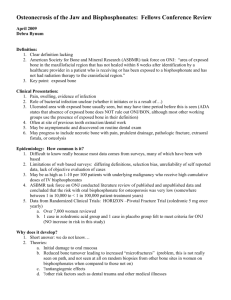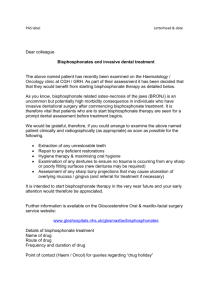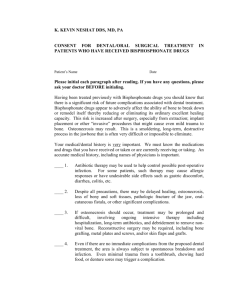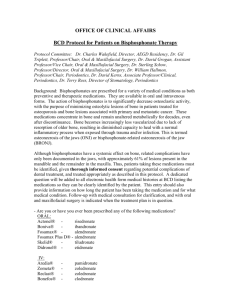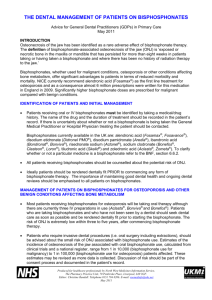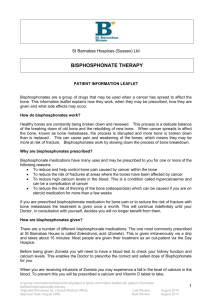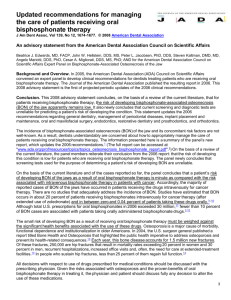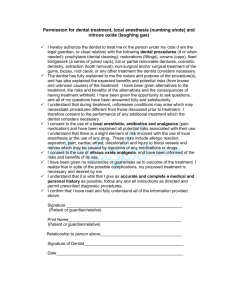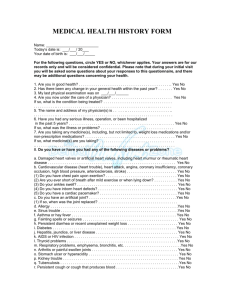What is Osteonecrosis of the Jaw?
advertisement
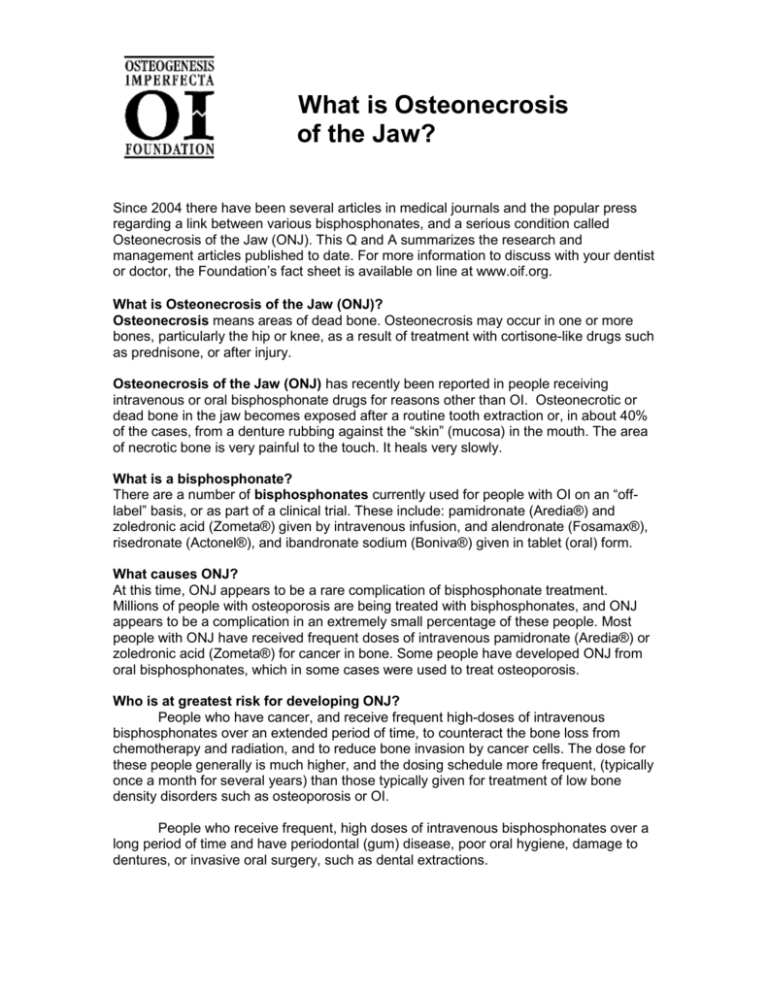
What is Osteonecrosis of the Jaw? Since 2004 there have been several articles in medical journals and the popular press regarding a link between various bisphosphonates, and a serious condition called Osteonecrosis of the Jaw (ONJ). This Q and A summarizes the research and management articles published to date. For more information to discuss with your dentist or doctor, the Foundation’s fact sheet is available on line at www.oif.org. What is Osteonecrosis of the Jaw (ONJ)? Osteonecrosis means areas of dead bone. Osteonecrosis may occur in one or more bones, particularly the hip or knee, as a result of treatment with cortisone-like drugs such as prednisone, or after injury. Osteonecrosis of the Jaw (ONJ) has recently been reported in people receiving intravenous or oral bisphosphonate drugs for reasons other than OI. Osteonecrotic or dead bone in the jaw becomes exposed after a routine tooth extraction or, in about 40% of the cases, from a denture rubbing against the “skin” (mucosa) in the mouth. The area of necrotic bone is very painful to the touch. It heals very slowly. What is a bisphosphonate? There are a number of bisphosphonates currently used for people with OI on an “offlabel” basis, or as part of a clinical trial. These include: pamidronate (Aredia®) and zoledronic acid (Zometa®) given by intravenous infusion, and alendronate (Fosamax®), risedronate (Actonel®), and ibandronate sodium (Boniva®) given in tablet (oral) form. What causes ONJ? At this time, ONJ appears to be a rare complication of bisphosphonate treatment. Millions of people with osteoporosis are being treated with bisphosphonates, and ONJ appears to be a complication in an extremely small percentage of these people. Most people with ONJ have received frequent doses of intravenous pamidronate (Aredia®) or zoledronic acid (Zometa®) for cancer in bone. Some people have developed ONJ from oral bisphosphonates, which in some cases were used to treat osteoporosis. Who is at greatest risk for developing ONJ? People who have cancer, and receive frequent high-doses of intravenous bisphosphonates over an extended period of time, to counteract the bone loss from chemotherapy and radiation, and to reduce bone invasion by cancer cells. The dose for these people generally is much higher, and the dosing schedule more frequent, (typically once a month for several years) than those typically given for treatment of low bone density disorders such as osteoporosis or OI. People who receive frequent, high doses of intravenous bisphosphonates over a long period of time and have periodontal (gum) disease, poor oral hygiene, damage to dentures, or invasive oral surgery, such as dental extractions. People who are taking intravenous bisphosphonates for cancer treatment, people who have received chemotherapy or corticosteroids, and those with poor oral hygiene, may have an increased risk of ONJ if they undergo invasive dental procedures. How many people with OI have ONJ? There are no reports of ONJ in people with OI. In a review of 41 cases of people with OI who were treated with bisphosphonates and had dental extractions, all of the patients had rapid healing with no infection. The patients received antibiotics before the procedures. How is ONJ treated? There have been some reports of healing and recovery in people with ONJ several months after they stop taking bisphosphonates, but the complications can linger. Treatment with systemic antibiotics and oral antibiotic rinses (Chlorhexidine) has been tried for pain relief and healing, but there is no clinical evidence that this helps. How can I prevent ONJ? Although ONJ has not yet been found in people with OI, the following recommendations promote good dental health and may reduce your risk of developing ONJ. In general, it’s a good idea to use the lowest effective dose of bisphosphonates for OI, and certainly to use a dose that is lower than that used for cancer treatment. If you are being treated with bisphosphonates or will begin bisphosphonate treatment, inform your dentist about the bisphosphonate treatment. Good oral hygiene along with regular dental care to prevent infections or periodontal (gum) disease is the best way to lower risk. Removable dentures should be examined for their potential to induce softtissue injury, especially tissue overlying bone, and adjusted if required Routine dental cleanings should be performed carefully, with emphasis on avoiding soft-tissue injuries Schedule required dental surgery prior to starting bisphosphonates, or, if possible, discontinue bisphosphonate treatment for several months before dental surgery, and do not resume bisphosphonate treatment until after the surgical area is healed. Start a course of antibiotics prior to the dental surgery Participate in a clinical trial or be under the care of a doctor who specializes in metabolic bone disorders and is knowledgeable about bisphosphonates. What should I tell my dentist? If you are being treated with bisphosphonates or will begin bisphosphonate treatment, inform your dentist about the bisphosphonate treatment. Review the Foundation’s fact sheet on ONJ and share it with your dentist. What should I do if my dentist recommends surgery? Any surgical procedure contains some risk, and the decision to pursue any surgical procedure should be undertaken with knowledge of possible benefits and risks. Often, but not always, third molars (also known as wisdom teeth) are extracted because they have a greater risk of causing some problem as the patient grows older. However, with the risk of ONJ associated with bisphosphonate therapy, it may be prudent to defer extractions of third molars and or other oral and maxillofacial surgery until more information is available regarding the risk in people with OI, and the length of time needed after stopping bisphosphonate therapy before the risk substantially decreases, unless there is a clear and extremely urgent indication for the surgery. There is no evidence to support or refute routine prophylactic removal of asymptomatic impacted third molars (also known as wisdom teeth) in adults, although there is evidence that even asymptomatic third molars that are visible in the mouth can have periodontal disease, which could possibly be associated with other local and systemic problems later. Typically people who are younger when they have third molars extracted have better outcomes than if the procedure is done later in older people. Deferring the extraction of third molars may produce a group of people who may not recover as well because of age, but also because of their accumulated bisphosphonate therapy, if some clear and urgent indication for third molar extraction becomes evident when they are older. These particular cases will require extreme caution and care. Endodontic (root canal) therapy is preferable to extractions when possible. It may be necessary to carry out removal of the tooth crown with subsequent root canal therapy on retained roots to avoid the need for tooth extraction and the potential development of osteonecrosis. Elective jaw surgery, including dental implants, should be avoided during intravenous bisphosphonate therapy. For more information, the following materials are available on the Foundation’s web site, www.oif.org: Bisphosphonates: An Information Update from the OI Foundation Medical Advisory Council; Fact Sheet: Dental Care for People with OI, Reprinted from the Summer 2006 issue of the OI Foundation newsletter Breakthrough. For more information about osteogenesis imperfecta contact: Osteogenesis Imperfecta Foundation 804 W. Diamond Avenue, Suite 210, Gaithersburg, MD 20878 Tel: 800-981-2663 or 301-947-0083 Fax: 301-947-0456 Web site: www.oif.org E-mail: bonelink@oif.org
